The form of our opening was conventional for the thriller genre as it has followed the conventions for a thriller opening however, our production started as a thriller/horror with use of some parts gore, however from our product being viewed it was shown that it was soley a thriller film.
The way we went about to fulfil these conventions were to use character exposition of the antagonist and protagonist in the opening sequence. The technical effect we used were mise-en-scene especially for costume and the lighting conditions for the killers bedroom, which was dim lighted. From our research we learnt that dim lighting was a stereotype for thriller films and to follow conventions we did the same. Also as shown in the picture below we found our footage to be red in colour therefore we decided to add a colourwash on to it making it more blue which adds to the cold feel of thriller film conventions.
 Research from the film Law Abiding Citizen(2009, Gary Gray) showed that character exposition is key and from undertaking a shot by shot analysis on it helped to show the framing of the antagonist and protagonist this gave great insight into our opening and helped us agree on the character exposition.
Research from the film Law Abiding Citizen(2009, Gary Gray) showed that character exposition is key and from undertaking a shot by shot analysis on it helped to show the framing of the antagonist and protagonist this gave great insight into our opening and helped us agree on the character exposition.
The way our production develops conventions is the way it has two time periods being inter cut to go against the conventional asynchronous narrative where it starts at the end and reveals from the beginning how it happened, we just decided to take that and have it inter cut to show insight and provide dramatic irony to the audience by creating a linear narrative.
How does your media product represent particular social groups?
For Mise-en-scene we knew that the best way to represent the social groups in our media product most effectively was through costume. The way we represented the working class killer was through him wearing a hoody, trackies and a balaclava to conseal his face. This is a dominant ideology of working class costume of which we wanted to represent. The two other characters are middle class ( the detective and journalist) both reinforce stereotypes of middle class males being well dressed(in suits) and well educated shown by there clothing and shown by the journalists house meaning he is succesful. 
The working class character is the killer who is represented in a negative way reinforcing dominant ideologies however this is challenged by the clues left behind showing that the killer is intelligent and working class social groups aren't associated with being clever. This helps to challenge ideologies and to get the audience attracted to the logic behind this man and to try and gain insight into why he is doing it.
Also what does reinforce stereotypes about males is there need to be dominance and aggressive which is shown by the ruthless killer as he takes his next victim who is vulnerable. Also crimes are associated with the working class people and is shown here in our media product. For the one bit of dialogue we have in our product is from the detective of which is deleivered in a laconic way.
What kind of media institution might distribute your media product and why?
I think our product would most likely be an industrial film due to it following most conventions of the thriller genre. Companies that are most likely to distribute thriller films are those that specialise in this genre or media conglomerates such as Universal who are merged with British film company working title. Thriller films appeal to a large audience of about 15- 40+ as they appeal to many sub genres aswell such as action, horror and psychological.
Previously the British film council has supported British films in helping to support funding for helping to produce and distribute there films, however since the scrapping of the UK film council has lead to less British films being made.
Click here to see my law abiding citizen shot by shot analysis.

















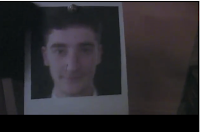 We incorporated violence into our sequence, the aftermath showing the dead body and a police detective investigating it. This is a convention of thriller films; to show the crime scene and the detective.
We incorporated violence into our sequence, the aftermath showing the dead body and a police detective investigating it. This is a convention of thriller films; to show the crime scene and the detective.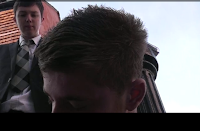 The antagonist left a signature item behind on his victim, which is conventional for serial killer films, such as 'Se7en' (
The antagonist left a signature item behind on his victim, which is conventional for serial killer films, such as 'Se7en' ( The form for our opening sequence was linear, and showed two lines of action inter-cut, and short scenes from a flash-back. I believe this is developing on the forms of real thriller and horror film openings, as they usually show a flashback at the start and then continue the narrative in the present, whereas our production integrates the flashbacks an
The form for our opening sequence was linear, and showed two lines of action inter-cut, and short scenes from a flash-back. I believe this is developing on the forms of real thriller and horror film openings, as they usually show a flashback at the start and then continue the narrative in the present, whereas our production integrates the flashbacks an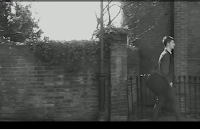
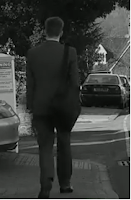 The social background of the antagonist is not explicitly shown, although it can be conveyed that he had a challenging upbringing which made him psychologically insecure which makes him commit the crimes, and possibly from a working class background. This is conveyed through his costume, consisting of dark clothing including a
The social background of the antagonist is not explicitly shown, although it can be conveyed that he had a challenging upbringing which made him psychologically insecure which makes him commit the crimes, and possibly from a working class background. This is conveyed through his costume, consisting of dark clothing including a  Our production conforms to dominant ideologies in film productions, as it is an action-driven sequence with the protagonist and antagonist being males, which is conventional for most thriller films. However, the victim is a male character, which may be seen as challenging dominant ideologies of women being the victims of a serial killer as they may be stereotypically portrayed as vulnerable.
Our production conforms to dominant ideologies in film productions, as it is an action-driven sequence with the protagonist and antagonist being males, which is conventional for most thriller films. However, the victim is a male character, which may be seen as challenging dominant ideologies of women being the victims of a serial killer as they may be stereotypically portrayed as vulnerable.  The production company, such as Universal Studios, would invest a lot of time and money into producing the film using sets and shooting on suitable locations. The distribution companies, for example Optimum Releasing, will organise how the film will be advertised, most likely through television and cinema advertisements in the form of trailers, posters,
The production company, such as Universal Studios, would invest a lot of time and money into producing the film using sets and shooting on suitable locations. The distribution companies, for example Optimum Releasing, will organise how the film will be advertised, most likely through television and cinema advertisements in the form of trailers, posters, 



 Using blogger.com has also been highly beneficial for the entire group, as it has enabled us to keep track of our production and post a record of our research, group decisions and shoots. The blog archive also enabled us to keep track of our work, and the ability to edit our posts allowed us to improve on past work.
Using blogger.com has also been highly beneficial for the entire group, as it has enabled us to keep track of our production and post a record of our research, group decisions and shoots. The blog archive also enabled us to keep track of our work, and the ability to edit our posts allowed us to improve on past work. I have also learnt to use
I have also learnt to use 


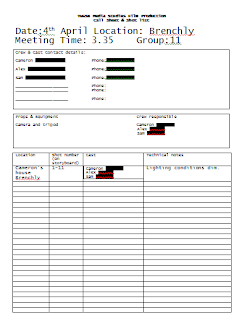 First off the call sheet identifies who is responsible for the kit and what kit we have taken out. Also it includes telephone numbers of the group for emergency contact. It identifies where we are going on our shoot.
First off the call sheet identifies who is responsible for the kit and what kit we have taken out. Also it includes telephone numbers of the group for emergency contact. It identifies where we are going on our shoot.